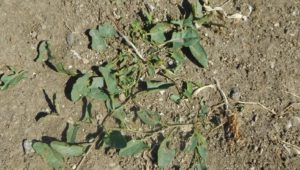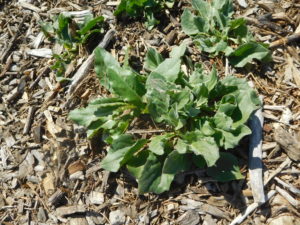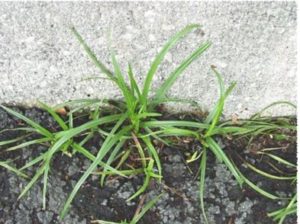The following weeds are the most difficult to manage and need to be attended to as early as possible. By the time these weeds are visible, an extensive network of roots has probably developed.
Bindw eed (Convolvulus arvensis) is a perennial that can quickly spread over an entire plot during warm weather. Most of the root system is in the top 2’ of soil but some vertical roots can go down to 20’. Constant vigilance is the main means of control. Pull out new shoots regularly and prevent the plant from receiving sunlight. Heavily overgrown areas may need to be treated with a systemic herbicide. http://ipm.ucanr.edu/PMG/PESTNOTES/pn7462.html
eed (Convolvulus arvensis) is a perennial that can quickly spread over an entire plot during warm weather. Most of the root system is in the top 2’ of soil but some vertical roots can go down to 20’. Constant vigilance is the main means of control. Pull out new shoots regularly and prevent the plant from receiving sunlight. Heavily overgrown areas may need to be treated with a systemic herbicide. http://ipm.ucanr.edu/PMG/PESTNOTES/pn7462.html
Perenn ial pepperweed (Lepidium latifolium, formerly Cardaria) is highly invasive perennial that grows rapidly during warm weather. Plant can grow 2’ high or more and produce abundant white flowers crowding out other plants. Roots tend to be extensive, thick and produce abundant new buds. Best way to control is to dig out the root system. Hoeing the plant may leave root segments in the ground which will produce new plants. Systemic herbicides are only marginally effective and need to be repeatably used.
ial pepperweed (Lepidium latifolium, formerly Cardaria) is highly invasive perennial that grows rapidly during warm weather. Plant can grow 2’ high or more and produce abundant white flowers crowding out other plants. Roots tend to be extensive, thick and produce abundant new buds. Best way to control is to dig out the root system. Hoeing the plant may leave root segments in the ground which will produce new plants. Systemic herbicides are only marginally effective and need to be repeatably used.
http://ipm.ucanr.edu/PMG/WEEDS/perennial_p epperweed.html
epperweed.html
Nutsedge is not a grass. It has long thin roots attached to tubers. There are 2 types: yellow nutsedge, Cyperus esculentus, and purple nutsedge, C. rotundus. They thrive in poorly drained soils. The tubers can grow 8” to 14” below the soil and produce new buds forming patches above ground. Roots and tubers need to be dug out. Systemic herbicides are only marginally effective and need to be repeatably used.
http://ipm.ucanr.edu/PMG/PESTNOTES/pn7432.html
